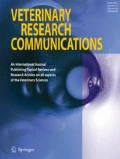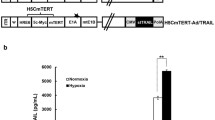Abstract
Adenovirus (Ad) vectors are widely used in cancer gene therapies. However, compared to human patients, relatively limited information is available on gene transduction efficiency or cell-specific cytotoxicity in canine tumor cells transduced with Ad vectors. Since epidermal growth factor receptor (EGFR) is highly expressed on canine breast tumor cells, we sought to develop an Ad vector based on the RGD fiber-mutant adenovirus vector (AdRGD) that expresses canine caspase 3 under the control of EGFR promoter. The aims of this study were to achieve high transduction efficiency with transgene expression restricted to canine breast tumor cells. Using EGFR promoter-driven AdRGD, we were able to restrict transgene expression to canine breast tumor cells with no evidence of expression in normal cells. Canine breast tumor cells transduced with EGFR promoter-driven AdRGD carrying canine caspase 3 gene showed cytotoxic activity. We constructed a second AdRGD vector that expressed oxygen-dependent degradation (ODD)-caspase 3 under the control of the EGFR promoter; the fusion protein contains a core part of the ODD domain of hypoxia inducible factor-1 alpha (HIF-1α) fused to caspase 3. Transduction of canine breast tumor cells with EGFR promoter-driven AdRGD expressing ODD-caspase 3 induced a higher rate of cell death under hypoxic conditions compared with under normoxia. The results indicate that the EGFR promoter-driven AdRGD vectors will be of value for tumor-specific transgene expression and safe cancer gene therapy in dogs.




Similar content being viewed by others
Abbreviations
- Ad:
-
Adenovirus
- CBT:
-
Canine breast tumor
- CMV:
-
Cytomegalovirus
- dCasp3:
-
Dog caspase 3
- DAPI:
-
4′,6-Diamidino-2-phenylindole dihydrochloride
- DFO:
-
Deferoxamine mesylate
- DMEM:
-
Dulbecco’s modified Eagle’s medium
- EGF:
-
Epidermal growth factor
- EGFR:
-
Epidermal growth factor receptor
- FBS:
-
fetal bovine serum
- FITC:
-
fluorescein isothiocyanate
- GFP:
-
Green fluorescent protein
- HEK:
-
Human embryonic kidney
- HIF-1:
-
hypoxia inducible factor-1
- IFU:
-
Infectious unit
- JAK-STAT:
-
Janus kinase signal transducers and activator of transcription
- MAPK:
-
Mitogen activated protein kinase
- MDCK:
-
Madin-Darby canine kidney
- MOI:
-
Multiplicity of infection
- ODD:
-
Oxygen-dependent degradation
- PBS:
-
Phosphate buffered saline
- PI3K:
-
Phosphatidylinositol-3 kinase
- RGD:
-
Arginine-Glycine-Aspartic acid
- RT:
-
Room temperature
- TGF:
-
Transforming growth factor
References
Bergman JG, Muniz M, Sutton D, Fensome R, Ling F, Paul G (2006) Comparative trial of the canine parvovirus, canine distemper virus and canine adenovirus type 2 fractions of two commercially available modified live vaccines. Vet Rec 159:733–736
Gilbertson SR, Kurzman ID, Zachrau RE, Hurvitz AI, Black MM (1983) Canine mammary epithelial neoplasms: biologic implications of morphologic characteristics assessed in 232 dogs. Vet Pathol 20:127–142
Harada H, Hiraoka M, Kizaka-Kondoh S (2002) Antitumor effect of TAT-oxygen-dependent degradation-caspase-3 fusion protein specifically stabilized and activated in hypoxic tumor cells. Cancer Res 62:2013–2018
Inoue M, Hasegawa A, Hosoi Y, Sugiura K (2015) A current life table and causes of death for insured dogs in Japan. Preventive Veterinary Medicine 120:210–218
Kaluzova M, Kaluz S, Lerman MI, Stanbridge EJ (2004) DNA damage is a prerequisite for p53-mediated proteasomal degradation of HIF-1alpha in hypoxic cells and downregulation of the hypoxia marker carbonic anhydrase IX. Mol Cell Biol 24:5757–5766
Kanegae Y, Makimura M, Saito I (1994) A simple and efficient method for purification of infectious recombinant adenovirus. Jpn J Med Sci Biol 47:157–166
Ke Q, Costa M (2006) Hypoxia-inducible factor-1 (HIF-1). Mol Pharmacol 70:1469–1480
Kim NW, Piatyszek MA, Prowse KR, Harley CB, West MD, Ho PL, Coviello GM, Wright WE, Weinrich SL, Shay JW (1994) Specific association of human telomerase activity with immortal cells and cancer. Science 266:2011–2015
Kim NH, Lim HY, Im KS, Kim JH, Sur JH (2013) Identification of triple-negative and basal-like canine mammary carcinomas using four basal markers. J Comp Pathol 148:298–306
Koizumi N, Mizuguchi H, Hosono T, Ishii-Watabe A, Uchida E, Utoguchi N, Watanabe Y, Hayakawa T (2001) Efficient gene transfer by fiber-mutant adenoviral vectors containing RGD peptide. Biochim Biophys Acta 1568:13–20
Li J, Liu H, Li L, Wu H, Wang C, Yan Z, Wang Y, Su C, Jin H, Zhou F, Wu M, Qian Q (2013) The combination of an oxygen-dependent degradation domain-regulated adenovirus expressing the chemokine RANTES/CCL5 and NK-92 cells exerts enhanced antitumor activity in hepatocellular carcinoma. Oncol Rep 29:895–902
Lu B, Makhija SK, Nettelbeck DM, Rivera AA, Wang M, Komarova S, Zhou F, Yamamoto M, Haisma HJ, Alvarez RD, Curiel DT, Zhu ZB (2005) Evaluation of tumor-specific promoter activities in melanoma. Gene Ther 12:330–338
Majhen D, Ambriovic-Ristov A (2006) Adenoviral vectors--how to use them in cancer gene therapy? Virus Res 119:121–133
Miura M, Zhu H, Rotello R, Hartwieg EA, Yuan J (1993) Induction of apoptosis in fibroblasts by IL-1 beta-converting enzyme, a mammalian homolog of the C. elegans cell death gene ced-3. Cell 75:653–660
Mizuguchi H, Hayakawa T (2002) Enhanced antitumor effect and reduced vector dissemination with fiber-modified adenovirus vectors expressing herpes simplex virus thymidine kinase. Cancer Gene Ther 9:236–242
Mizuguchi H, Koizumi N, Hosono T, Utoguchi N, Watanabe Y, Kay MA, Hayakawa T (2001) A simplified system for constructing recombinant adenoviral vectors containing heterologous peptides in the HI loop of their fiber knob. Gene Ther 8:730–735
Nagata S (1997) Apoptosis by death factor. Cell 88:355–365
Nagayama Y, Nishihara E, Namba H, Yokoi H, Hasegawa M, Mizuguchi H, Hayakawa T, Hamada H, Yamashita S, Niwa M (2001) Targeting the replication of adenovirus to p53-defective thyroid carcinoma with a p53-regulated Cre/loxP system. Cancer Gene Ther 8:36–44
Nerurkar VR, Seshadri R, Mulherkar R, Ishwad CS, Lalitha VS, Naik SN (1987) Receptors for epidermal growth factor and estradiol in canine mammary tumors. Int J Cancer 40:230–232
Nishi H, Nishi KH, Johnson AC (2002) Early growth response-1 gene mediates up-regulation of epidermal growth factor receptor expression during hypoxia. Cancer Res 62:827–834
Okada N, Saito T, Masunaga Y, Tsukada Y, Nakagawa S, Mizuguchi H, Mori K, Okada Y, Fujita T, Hayakawa T, Mayumi T, Yamamoto A (2001a) Efficient antigen gene transduction using Arg-Gly-asp fiber-mutant adenovirus vectors can potentiate antitumor vaccine efficacy and maturation of murine dendritic cells. Cancer Res 61:7913–7919
Okada N, Tsukada Y, Nakagawa S, Mizuguchi H, Mori K, Saito T, Fujita T, Yamamoto A, Hayakawa T, Mayumi T (2001b) Efficient gene delivery into dendritic cells by fiber-mutant adenovirus vectors. Biochem Biophys Res Commun 282:173–179
Okada Y, Okada N, Nakagawa S, Mizuguchi H, Kanehira M, Nishino N, Takahashi K, Mizuno N, Hayakawa T, Mayumi T (2002) Fiber-mutant technique can augment gene transduction efficacy and anti-tumor effects against established murine melanoma by cytokine-gene therapy using adenovirus vectors. Cancer Lett 177:57–63
Okada Y, Okada N, Mizuguchi H, Hayakawa T, Nakagawa S, Mayumi T (2005) Transcriptional targeting of RGD fiber-mutant adenovirus vectors can improve the safety of suicide gene therapy for murine melanoma. Cancer Gene Ther 12:608–616
Ryan HE, Lo J, Johnson RS (1998) HIF-1 alpha is required for solid tumor formation and embryonic vascularization. EMBO J 17:3005–3015
Sainsbury JR, Farndon JR, Needham GK, Malcolm AJ, Harris AL (1987) Epidermal-growth-factor receptor status as predictor of early recurrence of and death from breast cancer. Lancet 1:1398–1402
Sakurai H, Tashiro K, Kawabata K, Yamaguchi T, Sakurai F, Nakagawa S, Mizuguchi H (2008) Adenoviral expression of suppressor of cytokine signaling-1 reduces adenovirus vector-induced innate immune responses. J Immunol 180:4931–4938
Sano J, Oguma K, Kano R, Hasegawa A (2004) Characterization of canine caspase-3. J Vet Med Sci 66:563–567
Scaltriti M, Baselga J (2006) The epidermal growth factor receptor pathway: a model for targeted therapy. Clin Cancer Res 12:5268–5272
Sharma A, Tandon M, Bangari DS, Mittal SK (2009) Adenoviral vector-based strategies for cancer therapy. Current Drug Therapy 4:117–138
Sharma A, Tandon M, Ahi YS, Bangari DS, Vemulapalli R, Mittal SK (2010) Evaluation of cross-reactive cell-mediated immune responses among human, bovine and porcine adenoviruses. Gene Ther 17:634–642
Yamabe K, Shimizu S, Ito T, Yoshioka Y, Nomura M, Narita M, Saito I, Kanegae Y, Matsuda H (1999) Cancer gene therapy using a pro-apoptotic gene, caspase-3. Gene Ther 6:1952–1959
Acknowledgments
This study was partially supported by a project grant (Young Scientist Research Training Award) to MO funded by the Azabu University Research Services Division, and a Grant-in-Aid to MO from Japan Society for the Promotion of Science (No. 26450450).
Author information
Authors and Affiliations
Corresponding author
Ethics declarations
Conflict of interest
None of the authors have any conflict of interests.
Additional information
Mariko Okamoto and Ai Asamura contributed equally to this work.
Electronic supplementary material
Supplementary Fig. 1
Quantitative PCR (qPCR) Total RNA was extracted from CBT cells transduced with AdRGD-hEGFR/dCasp3 or AdRGD-hEGFR/ODD-dCasp3 respectively using Ribozol RNA Extraction Reagent (Amresco, Solon, OH, USA). Single-stranded cDNA was synthesized from total RNA using PrimeScript II 1st strand cDNA Synthesis Kit (Takara Bio Inc., Kusatsu, Shiga, Japan). Exogenous gene expression of caspase-3 or ODD-caspase 3 was determined by real-time qPCR with DyNAmo ColorFlash SYBR Green qPCR kit (Thermo Fisher Scientific, Massachusetts, USA) according to the manufacturer’s instructions. The selected gene expression was calculated using ribosomal protein (RP) S18 as a normalization control according to the comparative CT method. Exogenous caspase-3 or ODD-caspase 3 expression in CBT cells transduced with hEGFR promoter driven adenovirus vector (a) CBT cells were transduced with AdRGD-hEGFR/dCasp3 or AdRGD-hEGFR/ODD-dCasp3 at 0, 5, 15, or 45 MOI respectively. After 24 h, mRNA expression was assessed by qPCR. Primers used in qPCR to detect exogenous caspase-3 or ODD-caspase 3 expression were shown by blue arrow in schematic representation of Ad-vectors. (b) CBT cells were transduced with AdRGD-hEGFR/dCasp3 or AdRGD-hEGFR/ODD-dCasp3 at 0, 5, 15, or 45 MOI respectively. After 48 h, protein expression was assessed by western blotting (PPTX 59 kb)
Supplementary Fig. 2
Reduction of mitochondrial membrane potential in CBT cells transduced with AdRGD-hEGFR/dCasp3. CBT cells were transduced with AdRGD-hEGFR/dCasp3 at 0 or 45 MOI for 24 h. Mitochondrial membrane potential was verified by flow cytometric analysis. (PPTX 24 kb)
Supplementary Fig. 3
Active caspase 3 expression in CBT cells transduced with AdRGD-hEGFR/dCasp3. CBT cells were transduced with AdRGD-hEGFR/dCasp3 at different MOI values, and active caspase 3 was detected using an antibody against active form of caspase 3 (PPTX 577 kb)
Supplementary Fig. 4
Dominant expression of ODD-caspase-3 under hypoxic conditions. (a) CBT cell were transduced with AdRGD-hEGFR/ODD- dCasp3 at 45 MOI under normoxic (Normoxia) or hypoxic (Hypoxia) conditions. ODD-caspase 3 expression was assessed by western blotting. HIF-1α expression in CBT cells under normoxic (Normoxia) or hypoxic (Hypoxia) conditions was also assessed by western blotting. (b) CBT cell were transduced with AdRGD-hEGFR/ODD- dCasp3 under the same conditions as in (A), and active caspase 3 was detected using an antibody against active form of caspase 3. (c) CBT cell were transduced with AdRGD-hEGFR/ODD- dCasp3 under the same conditions as in (A), mitochondrial membrane potential was verified by flow cytometric analysis. (PPTX 130 kb)
Rights and permissions
About this article
Cite this article
Okamoto, M., Asamura, A., Tanaka, K. et al. Expression of HIF-1α ODD domain fused canine caspase 3 by EGFR promoter-driven adenovirus vector induces cytotoxicity in canine breast tumor cells under hypoxia. Vet Res Commun 40, 131–139 (2016). https://doi.org/10.1007/s11259-016-9664-7
Received:
Accepted:
Published:
Issue Date:
DOI: https://doi.org/10.1007/s11259-016-9664-7




